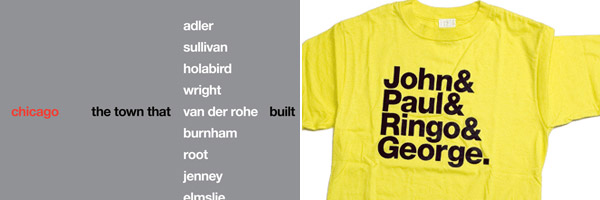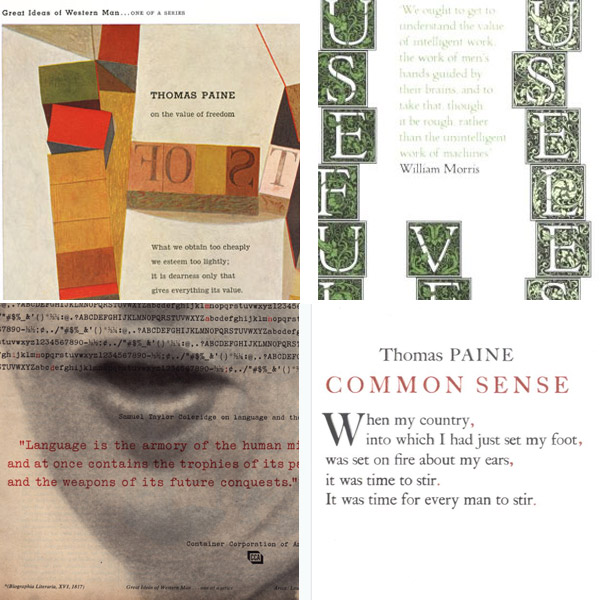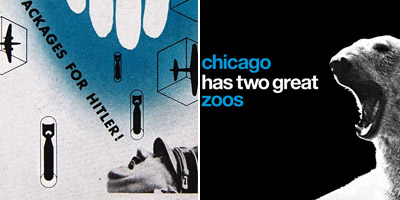Today, Gapers Block had a nice find that's been making the rounds: Flatmade's resurrection of posters by John Massey and John Rieben, designed for the Container Corporation of America's 1966 Chicago Cultural Communication Project. In Rieben's and in "Land-Ho Chicago," I see an echo of a recent, popular design meme that started with the Amsterdam design studio Experimental Jetset:

(My favorite iteration, though I can't find it now, is a shirt for the UNLV Runnin' Rebels of Johnson/Augmon vintage.)
Rieben and Massey both worked for the Container Corporation of America as designers, under executive and industrialist Walter Paepcke, and therein hangs a tale.
Paepke was the son of an immigrant and lumberman: Herman Paepcke, founder of the Chicago Mill and Lumber Company, the logging giant that's been blamed for the extinction of the ivory-billed woodpecker. Herman Paepcke died a very wealthy man in 1922, with an estate valued between three and eight-and-a-half milion dollars ($41 to $109 million in today's money), though by 1938, after the Depression, it was allegedly worth nothing. His son Walter grew up in high society—he first met his wife Elizabeth, the brother of diplomat Paul Nitze and daughter of U. of C. romance-languages prof William Nitze, when she was seven; when their daughter Antonia made her debut, it headlined the Tribune's society column.
In 1926, Paepke started his own company, the CCA, an amalgamation of 14 small firms that was built out from Chicago Mill and Lumber. Like his father's company, it was a success, bringing in $20 million after a decade in business and, around the time of Paepcke's death, employing 20,000 people. An industrialist who made his fortune on cardboard boxes would seem like an unlikely patron for visual design, but Paepcke was influenced by his wife, who studied at the Art Institute and went on to become a theater designer and decorator, and the European-expat and intellectual circles they traveled in:
The couple spoke German at home; their daughter, Antonia, says she was at a disadvantage for not knowing English when she started school. After World War II, the Paepckes tried to revive an appreciation of German culture by staging a bicentennial celebration of the birth of Goethe—in, of all places, Aspen.
The "Aspen Institute for Humanistic Studies" was organized by Walter and Elizabeth Paepcke and her brother Paul, along with U. of C. president Robert Maynard Hutchins and Hutchins's employee, philosopher Mortimer Adler. Now known as just the Aspen Institute, it's preserved its synthesis of elite leadership, commerce, politics, and the arts that emerged from the big ideas and open markets of the mid-century University of Chicago.
The Paepckes are now best known for the Aspen Institute, but Paepcke left a timeless imprint on Chicago's design history. Walter Paepcke was instrumental in bringing Laszlo Moholy-Nagy to Chicago, where his New Bauhaus eventually evolved into IIT's Institute of Design. According to Ted Conover, it was Elizabeth (influenced by Adler's Great Books reading group, another U. of C. legacy) whose idea it was to run an ad campaign called "Great Ideas of Western Man," featuring the work of designers like Milton Glaser and Saul Bass. The "Great Ideas" campaign reminds me of Penguin's deservedly acclaimed Great Ideas books series, with its emphasis on text as design (left, details of CCA ads from Neil Fujita and Louis Danzinger; right, Penguin Great Ideas covers).

Under Paepcke, CCA employed a vast, eclectic range of designers, using everyone from Dadaist Man Ray to future children's-book star Tibor Gergeley to legendary French poster designer Jean Carlu for a striking wartime collection that was immediately more forward-looking than the lurid victory posters of popular fame; the range of ads displayed at the Art Institute in one 1945 exhibition still looks contemporary, in part because so many of them remain famous and influential. Paepcke's embrace of modern currents in design changed the look of American advertising and industry, and with it the taste of Americans in the mid-20th century, forging a style that still drives American culture:
Hungarian designer László Moholy-Nagy founded the Institute of Design in Chicago in 1944, and with workshops by György Kepes established a modernist approach to advertising design that would rival that of New York. Also emanating from Chicago was the design program of the Container Corporation of America, under the patronage of founder Walter Paepcke. His mandate to challenge the design establishment altered the everyday advertising of It was a fertile time for the advertising world. The era of the “Mad Men” was in full swing.
You can see, for example, how Carlu's "Gift Packages for Hitler" poster speaks to another of Flatmade's Chicago series, the forthcoming "Chicago has two great zoos" poster by John Rieben, twenty years down the line:

Massey and Rieben's sparse, elegant design is well within that modernist current, one that was brought to the Chicago advertising world by Paepcke—who hired Massey and Rieben for the forward-looking CCA, and who also brought Moholy-Nagy to the city. But it wasn't just the creation of Walter Paepcke. His wife, her diplomat brother, her professor father, and their public-intellectual friends in Hutchins and Adler were all elements in a synthesis of mass commerce, modern utopianism, high culture, and big ideas, the strains of which can be found from the Great Books of the Western World to the Chicago Cultural Communication Project to the Aspen Institute.
Related: A video about the International Design Conference in Aspen, also founded by Paepcke.


